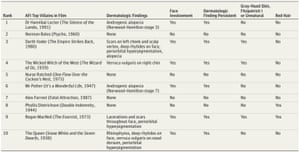Bulbous noses, warts and dark circles under the eyes are among the skin conditions commonly used by filmmakers to indicate villains, researchers have found.
A study by a team of US dermatologists has highlighted that while heroes of the silver screen typically have barely a mark on their features, characters with dubious morals are often depicted with all manner of skin traits – an association that, the researchers say, is damaging.
“It something that has been perpetuated in film, sometimes maybe even unintentionally, but it is something that has become more and more prevalent over the years,” said Julie Amthor Croley, co-author of the research from the University of Texas.
“It is not only perpetuating this tendency towards discrimination towards people with skin disease but it also does affect the person on an individual basis,” she added.
For the research, published in the journal JAMA Dermatology, Amthor Croley and colleagues began by scrutinising the appearance of the top ten heroes and villains as rated by the American Film Institute.
Top of the list of ne’er-do-wells was Hannibal Lecter, from The Silence of the Lambs, followed by Norman Bates of Psycho, Darth Vader of Star Wars, and the Wicked Witch of the West from the Wizard of Oz. The virtuous list, meanwhile, was topped by Atticus Finch from To Kill a Mockingbird and included, among others, James Bond, TE Lawrence, and Rocky Balboa.

The team found that while skin features or conditions were common among the villains, cropping up in six of the ten cases, they were largely absent among the heroes – only Indiana Jones from Raiders of the Lost Ark and Rick Blaine from Casablanca were found to have scars, and then only single marks. What’s more, these scars belonged to the actors rather than being the handiwork of makeup artists, and were subtler and shorter than those of villains.
Baddies, however, had a host of skin problems ranging from warts, as found on the chin of the Wicked Witch of the West, to a condition known as rhinophyma which can cause a bulbous, red nose – such as that of the Queen in Snow White who, when in her hag-like disguise, was also found to sport deep wrinkles.
Regan MacNeil of The Exorcist also appeared on the top ten list of evil characters. The dark circles under her eyes and scars on her face are features also seen – together with deep wrinkles, grey skin and alopecia – in Darth Vader when he takes off his mask. The result, according to the authors, is that Vader “manifests sheer evil and incites apprehension and fear of the unfamiliar.”
“All these associations of skin findings with film villains date back to the silent film age in a time when all filmmakers had to communicate [with] was visual cues, they didn’t have spoken word,” said Amthor Croley, adding that one villain often sported multiple skin conditions, designed to hint at a nefarious character. “With specific reference to scars, filmmakers may use them to illustrate a sort of a stormy past filled with violence,” she added.
Beyond the top ten lists, the team point to other features which have frequently been linked to movie villains, including albinism – a condition seen in killers in the Da Vinci Code and Cold Mountain, among other films.

While the study does not consider whether many features such as hair loss were intended, prosthetic or just a natural feature of the actor, and only considers a small range of characters, experts say the research highlights an important issue.
“Skin disease is often trivialised as being nothing more than cosmetic disfigurement, but as this study shows, society holds deep-seated stereotypes about the association between skin appearance and personality,” said Kim Thomas, professor of applied dermatology research at the University of Nottingham, who was not involved in the research.
“Such stereotyping can be psychologically devastating for people suffering from common skin condition such as vitiligo, warts, acne and hair loss,” she added. “At a time when cash-strapped health services are talking of limiting medical treatment for cosmetic conditions, it is timely to be reminded of the wider impact that visible disfigurement can have on those affected.”
James Partridge, chief executive of the charity Changing Faces, said that findings of the study were not surprising. “For years, facial differences, such as dermatological conditions, scars or alopecia, have been used to indicate a villainous character. What concerns us is that this type of visual shorthand is used without any thought as to how it might affect the lives of real people with a visible difference,” he said.
“We want the film industry to take a more balanced approach,” he added. “Why can someone with a disfigurement not play the kind parent, the supportive teacher, the famous actor or even the president?”
Big screen baddies and their skin conditions unpicked by dermatologists
Hiç yorum yok:
Yorum Gönder